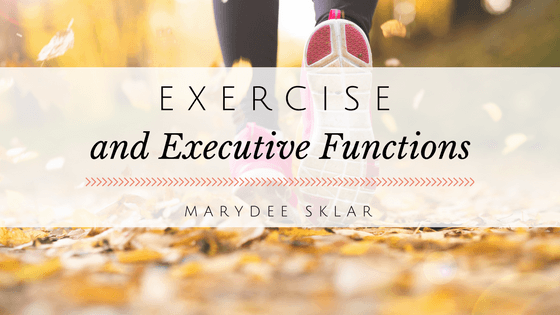At first glance, you might not realize that an exercise habit is directly linked to your brain’s executive functioning. I was considering this fact last week as I did my three-mile Sunday jog around my neighborhood. I’ve been doing this for so long that I have forgotten when I started. I had to ask myself: what executive functions am I engaging when I make the choice to exercise? According to the model put forth by Peg Dawson and Richard Guare, two very well respected leaders in the world of EF’s, here are the executive functions that we use when we decide to exercise:
- Metacognition, or thinking about your thinking: this is self-awareness, in part having the consciousness to choose to exercise.
- Response Inhibition, or self-control: this is the ability to listen to the ‘wiser’ voice in your head and not give into the voice that says: ‘Umm, not today…I don’t feel like it, I’m too tired, I don’t have time.’
- Time Management: This is the ability to plan the space of time in your day or week for exercise.
- Planning and Prioritization: The planning part refers to what I call “future thinking.” In this case it is the understanding that exercise today will pay off in the future with better health. And prioritization is the ability to put yourself first, since brain and body health are key to an easier life over the long haul.
- Task Initiation, or getting started: just the effort of putting on exercise shoes or clothes can thwart our good intentions. (HINT: Put your exercise clothes IN SIGHT when you go to bed so you see them first thing when you wake up.)
- Goal-Directed Persistence, otherwise known as ticking with it. This is making a commitment to yourself to keep at exercising even when you don’t want to.
The truth is that making the choice to follow a habit every day is a great way to practice engaging those six executive functions.

Typically when I jog, I cross paths with a few neighbors. Often it is Helen, a younger woman. I can hear her coming up behind me, her feet keeping a much faster pace than mine. She may pass me three times before I finish my three miles.
Another neighbor is Jan, 90-years young, who walks around the block, albeit very slowly these days. As I passed him for the second time, he commented that he was not winning the race. I laughed and told him about how Helen makes me feel so slow. “We’re not racing,” I said, “but we get points just for being out, moving our bodies,” (and helping our brain health too).
Jan shared with me that in his younger days he walked to and from work at Portland State University. It is a three and half mile trip one way with a very significant hill which, in some states, would be a called a mountain. That story inspired me. I bet all of that exercise has helped with his longevity. He still has a great mind too!
So, take a look at your brain and your executive skills. Which skills do you need to focus on to develop and maintain an exercise habit? Then you start, with just one step at a time.
Little by little,
Marydee

